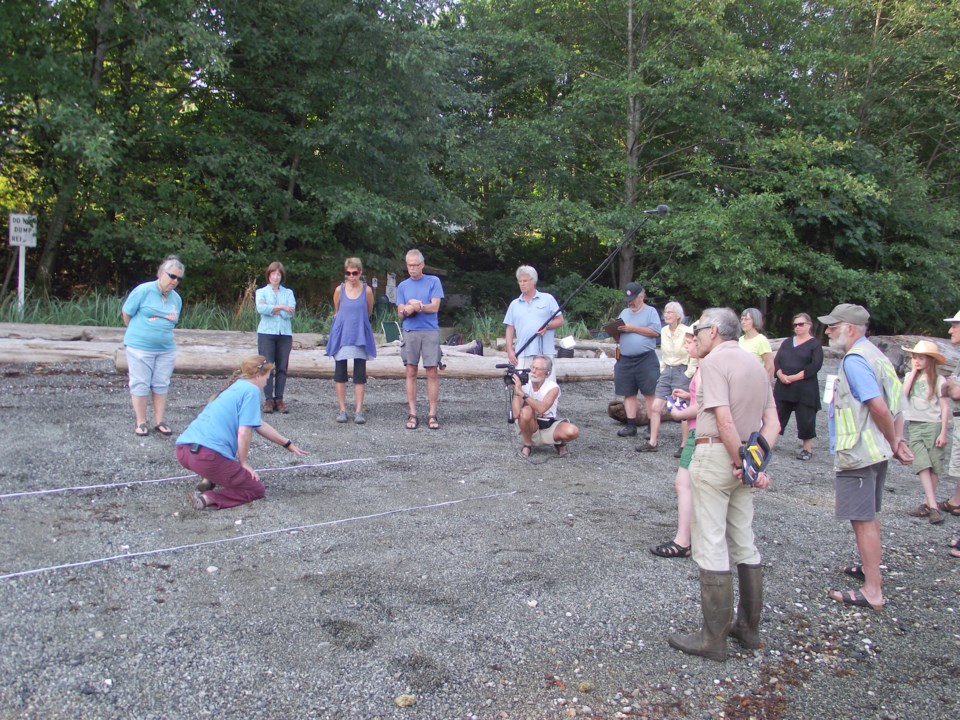I’m one of those people who never see anything in a microscope. Others get to ooh! and ahh! at a speck of something I never get to observe. So it was with low expectation that I peered into the microscope to look at the surf smelt embryos at Ramona de Graaf’s Forage Fish Workshop on August 11th.
I saw them! Little round pearls with eyes and squiggles. Ramona, also known as Queen of the Smelts, said it was her favourite microscope. Maybe that had something to do with it. Or perhaps it was Ramona’s enthusiasm and passion for forage fish. Now I could see what all the fuss was about: a new community on Bowen to discover. So I joined a team – Bowen Island Friends of Forage Fish – dedicated to surveying and mapping the beaches where these fish spawn. About a dozen of us are about to become Citizen Scientists.
Forage fish are not the kind of fish you are likely to see on posters, nor are they listed in Canada’s Food Guide. But they’re tasty and they used to be plentiful. They are the foundation of the food web on the west coast. Just about everybody eats them. These wiggly fish – surf smelt, sand lance, herring and others – are a major source of food for sea birds, salmon, lingcod and rockfish, which in turn, feed whales, sea mammals, and humans. If we want the big fish in our waters, we have to set a nice table for them.
Ramona, who gave up a successful law career to become a marine biologist, has worked with over 30 communities in B.C. teaching them about forage fish and training them to find embryos on local beaches. The coast of B.C. once had millions of forage fish; today, the populations are in dramatic decline. Qualicum Beach is one of the last commercially viable herring areas in the Salish Sea. As a result, many of the birds, fish, and mammals that rely on them are also in decline.
“It’s more than just a pretty beach,” says Ramona, which inspired me to write a song with the same title. Stop me on the street and I’ll sing it for you. “That’s where the forage fish spawn,” she adds. The sand lance spawn from November to February. The surf smelt were once thought to spawn only in the summer. Ramona is now discovering that they spawn all year round.
The female surf smelt swims onto the shore, and when she feels the pea-sized pebbles on her body, she lays her eggs in the sand and the male lays his sperm on top of the eggs. Once the egg is fertilized, it forms a suction cup that attaches to a pebble for safety. For Pacific sand lance (otherwise known as needlefish) procreation is a community effort. The females, in a group, swim up the beach. Together they make a dinner-plate sized depression, lay their eggs in it and await the attention of the males. The embryos will stay for a couple of weeks before they hatch and swim out into the big world.
Not that long ago, so the old timers tell me, one could go to Sandy Beach and easily gather a bucket full of smelt for a mighty tasty supper. That’s where we’re headed, on a clear bright morning, in search of embryos. We measure off 30 metres in between the high tide and the low tide where they are likely to spawn. Ramona tells us to have faith even if we don’t understand all the data and the science stuff. I don’t. “Fish don’t spawn according to the literature,” she reminds us.
We shovel gravel. We sieve. We add more sea water. We sieve. We sing. We winnow – much like a belly dance motion as you shake and stir the pan. Ramona compares it to panning for gold but the treasure we seek is smelt embryos. Ramona says, “keep doing it as long as you’re having fun.” So far so good. Every two weeks our teams will go to the same beach, take samples, winnow, winnow, winnow, gather data, and send it off to Ramona.
Bowen is in a good position, says Ramona. “Your neighbour, West Vancouver, has plenty of surf smelt caught commercially.” We don’t know for sure if they’re here on Bowen beaches but we’re going to do our best to find out.
Next time you go to your favourite beach, be aware of the community of forage fish that may just be in search of a nursery.
And you might want to say “Shhhh! Beach babies are sleeping.”



